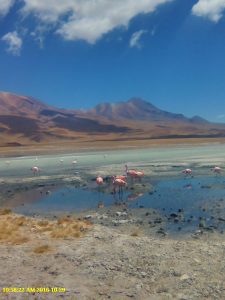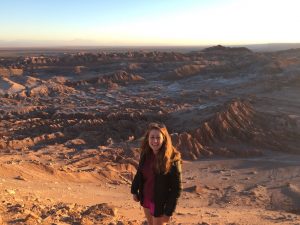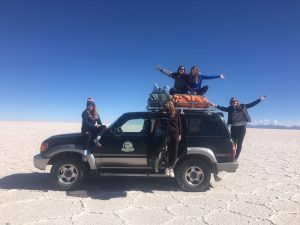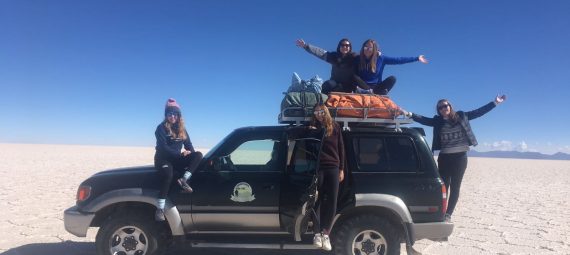A 2 day public holiday for All Saints Day meant we took the opportunity to escape up north to visit the Atacama Desert and take a tour of the south western Bolivian national parks.
We arrived in San Pedro de Atacama, effectively a base town for excursions to the desert and Bolivia, booking our tour the day we arrived; speaking Spanish with the agencies is essential to avoid being overcharged, and it’s worth going to several agencies before signing up to ensure you’re getting the best deal. The next day, we arrived at the Chile-Bolivia border for about 8am where we battled the winds to eat a hearty breakfast. Here we met our Bolivian guide and driver, David, before heading out to explore the wilderness.
Day 1 consisted of visiting the Laguna Blanca, volcanoes, geyser fields and the Laguna Verde; as the wind picked up, we witnessed a vibrant green colour sweep over the lake due to the disturbance of minerals. We finished off at the Laguna Colorada, a shallow but vast lake rich in minerals, giving it a vibrant red colour. Flamingos abound in the area, migrating there during the spring to feed from the mineral rich waters. The sheer size and striking colour of the lake certainly put it up there with one of the best stops on the trip. Cameras simply do not capture the beauty of it; it was truly spectacular. We then spent our first night in a desert hamlet not so far from the lake, where we ate a 3 course dinner prepared by 3 Bolivian women. The supply of electricity and water is unsurprisingly very limited in the desert, so showering facilities are scarcely provided and generators cut off not long after dinner.
We began day 2 with a 6am start, heading through the desert, passing volcanoes, rainbow mountains, high altitude lagoons, and landscapes dominated by volcanic bombs. We fed bread to wild rabbits, chased llamas and spotted wild chickens and desert foxes; the ability of these animals to survive in such conditions is quite astonishing.
Having all fallen asleep in the car on day 1, our guide was determined to keep us awake from now on. Every 5 minutes it seemed, we would hear the call of ‘Chicas, están dormiendo?’ (girls, are you sleeping?) to which we would incessantly reply ‘NO DAVID, of course not!’ We then introduced him to some of the old classics on our Ipods; driving through the Bolivian desert blasting out the Backstreet Boys and Busted was certainly a surreal experience!
We then continued driving, reaching much greener landscapes; quite the opposite to what we had seen in the morning. After stopping for a lunch of homemade lasagna, with salad, tuna and rice at David’s ‘secret spot’ by a river, we continued driving through the grassy plains, gorges and up mountains, passing tiny remote villages. Recent investment from the government into basic roads that allow trucks to deliver goods has enabled these communities to survive. Finally, we reached a salt hostel where we spent the night. Everything but the roof was made from salt, from the tables, to the beds, to the walls, but to our surprise, we had the warmest night here, despite having a shower quite literally under an ice cold drip!
We were up at 4am on day 3 in order to make sunrise at the Cactus Island. Somehow David managed to drive us there in the dark, with no GPS or map; the guides’ sense of direction is almost superhuman, demonstrated by their ability to direct themselves to a specific spot amongst the vast ‘nothingness’ of the salt flats. But the early start was 100% worth it; seeing the sun rise over a never ending sheet of white was truly spectacular. This was followed up by a top notch breakfast on the salt flats. Then of course, we proceeded to take an infinite number of photos on the flats, playing with the perspective to get some pretty cool snaps of us running away from dinosaurs or stepping on each other. We then passed by an artisan village, stocking up on Inca style jumpers and socks made from llama fur, trying quinoa juice and then finished with a lunch of grilled llama and quinoa. Llama is supposedly one of the leanest meats you can get, with the lowest cholesterol content; David, having previously worked in the field of nutrition analysis, was an avid promoter of the consumption of llama meat. To be honest, to us it seemed pretty much like a bit of tough beef, but I shall reserve judgment until I try it again!
Before driving to our final hostel for the night, we visited the train sanctuary in Uyuni, where a long line of trains and their carriages were left to rust following the abandonment of the expansion of the train network during the 19th century. In comparison with all the natural beauty we had witnessed over the previous few days, this was a strange end to the tour but interesting in terms of the history all the same!
On day 4 we headed back to San Pedro de Atacama, where we spent two more days horse riding, star gazing and visiting the Valle de la Luna (the Moon Valley). We climbed through caves, walked up the Salt Mountain range and watched the sun set over the fantastical landscape of stone and sand formations carved over millions of years by winds and floods. It truly was like something out of a fairy world or Harry Potter, and the only valley of its type in the world.
Our week in the Atacama and southern Bolivia was truly an unforgettable experience. We saw landscapes that are truly unique to this part of the world, so expansive and so diverse. There are few places in the world where you could see such a diverse range of geographical landscapes and features in 4 days. Sadly however, our children or grandchildren may never get to see them; lithium extraction threatens the existence of the biggest salt flats in the world. The evident poverty of those living in rural towns was also striking, and a stark reminder of the persistent inequality in Latin America.
And so, next stop, Easter Island (…after finishing a few group projects and presentations!)
Hasta luego,


Beth



